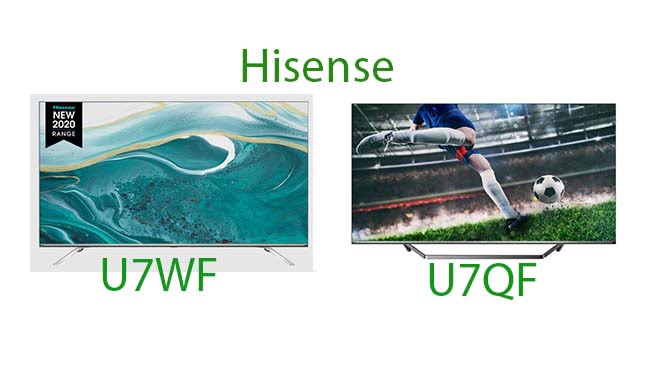Have you heard about Hisense ULED TV and wondering what it is all about? Do you know about the ULED TV, but still can tell the difference the U7WF and U7QF TV models. If that is the case, then you are in luck. In today’s world, OLED (organic light-emitting diode) TVs are the bomb. Pioneered by LG, OLED TV produces better image quality as well as reduced power consumption. While the technology might be great, it has its own downside and this is where the ULED comes in.
If this is your first time of hearing the word ULED, but have heard of Samsung QLED, the truth is that they both mean the same thing. As we may well remember, Samsung QLED TV is an answer to LG OLED TV. Hisense ULED is just the term the company coins for their own version of QLED.
Just in case you don’t know what all these stands for, the QLED means Quantum-dot Light-Emitting Diode, while the ULED means Ultra Light Emitting Diode. While both names may sound and look different, both apply the same technology. That is, both mean the same thing. ULED is just Hisense own acronym for Samsung’s QLED technology.
Today we should be looking at Hisense’s U7WF And U7QF ULED TVs. While both TV models have been around for quite some time, many people still don’t know the difference between them. Before we take a look at the two models, check out how OLED differ from QLED or ULED below.
What is OLED?
The term OLED means organic light-emitting diode and this is an advanced form of LED. On regular LED TVs, there have backlights that provide light to pixels, but for the OLED, instead of the lights, it uses an organic material made of hydrocarbon chains to emit light. On OLED TVs, every pixel produces its own light, thereby giving it a high contrast ratio. The great advantage of OLED TVs aside been very slim, is that it produces a better picture and image quality over QLED. Other advantages include, saves energy, It produces true black (i.e. Black areas of the TV, starts black and they do not appear gray) and has a better refresh rate.
What Is QLED/ULED?
The term QLED means quantum dot light-emitting diode and its very similar to the LED. ULED on the other hand, means Ultra Light Emitting Diode. The QLED/ULED still make use of backlight, but not just the same way as the LED TVs. In a common term, the QLED/ULED TV, is an advance LCD TV with a better LED lighting system. Some of the advantages of QLED/ULED over OLED, include producing a brighter image and picture quality. It is cheaper and most of all, it doesn’t have burn-in like in OLED TVs.
Difference Between Hisense U7WF And U7QF TVs
Hisense U7WF: The Hisense U7WF comes running on the VIDAA 4.0 operating system. It is available in 55, 65 and 75 inches and it is available in black colour with a resolution of 3840 x 2160. The U7WF model has up to 450 cd/m2 level of maximum brightness and a contrast ratio of 6000 : 1. It comes with 4 HDMI ports and 2 USB ports.
The Hisense U7WF does not support Quantum dots, but features Wide Color Gamut, 4K, Dolby vision and Full array Local Dimming. See features below.
Features Of Hisense U7WF
- Sizes: Available in 55, 65 and 75 inches
- Resolution: 3840 x 2160
- Refresh Rate: 60Hz
- Native contrast ratio: 6000 : 1
- Doesn’t comes with Quantum dot but features Wide Color Gamut
- Supports 4K
- Supports Dolby vision
- Full array Local Dimming
- DTX-Virtual
- Comes with four (4) HDMI
- Two USB Ports
- Ethernet
- Wifi
Hisense U7QF: The Hisense U7QF also comes in 55, 65 and 75 inches and it’s available in black colour. It sports an Ultra HD display, with a resolution of 3840×2160. The TV is powered by a Quad Core/MSD6886 processor and runs on the VIDAA 4.0 operating system. It comes with a Peak Brightness of 700 nits and has a contrast ration of 6000 : 1.
The Hisense U7QF supports Quantum dots display and it comes with a refresh rate of 120Hz. It supports 4K, both Dolby Vision and Dolby atoms, wide colour gamut,
Features Of Hisense U7QF
- Sizes: Available in 55, 65 and 75 inches
- Resolution: 3840 x 2160
- Refresh Rate: 120Hz
- Native contrast ratio: 6000 : 1
- Wide Color Gamut
- Supports 4K
- Supports both Dolby Vision and Dolby atoms
- Full array Local Dimming
- DTX-Virtual
- Comes with four (4) HDMI
- Two USB Ports
- Ethernet
- Wifi
Conclusion:
Aside the few spec differences, the Hisense U7QF comes as a premium version of the two TVs. While it supports Quantum dot, the U7WF model does not. The U7WF is cheaper, but the U7QF offers a better picture quality and brightness.
